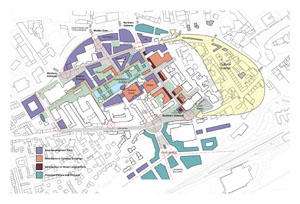

A campus vision 
"A stunning new vision for the future",
"Essential for successful teaching and learning"
"A plan we cannot afford financially or strategically, not to have"...these were some of the reactions to the new campus plan adopted by Court after a wide consultation process.
Imagine a pedestrianised campus with impressive "civic gateways" to north and south, joined by a main walkway where academic buildings, interspersed with occasional shops, open onto the main thoroughfair and staff and students gather between lectures to chat on a common green at its very heart …
This in essence, is the vision for The Campus in the City over the coming years. The strategy, developed in conjunction with the City and Scottish Enterprise Tayside, was drawn up by architects Page and Park of Glasgow who designed the award winning campus strategy for Strathclyde University and who were behind the Lighthouse centre in Glasgow. It sets out a holistic vision for the gradual development of the precinct into the 21st century.
Under the new strategy a pedestrianised Small's Wynd would become the main artery through campus joining an impressive architectural link with the city at the north end of the campus - possibly the new Northern College building - down to the Perth Road where the vision extends to a stylish terraced link heading south to the river, with little businesses and incubator units spawning to either side.
At present most buildings on Small's Wynd have their entrances elsewhere, presenting a blind and dead frontage to pedestrians, but the new plan would readjust their main doors to open onto the main thoroughfair allowing passers by to see the activities going on, enhancing the university's 'shopfront' and contributing to interest, safety and security.
Arguably the most exciting proposal is a central college green - an open grass space for recreation at the back of DUSA, between the MicroCentre and Duncan of Jordanstone College. This would take in much of Belmont's recreation area and extend through the site currently occupied by tennis and squash courts. It follows a huge consensus that what the precinct needs is a fundamental core - and that the core should be "soft" and service in nature rather than "hard" and academic.
"A college green would create a central heart for campus activity while physically anchoring the main academic clusters to a central point,"explained David Page.
Other features of the vision include a civic space in front of the Tower extending into a vibrant city cultural quarter which curves round via DCA and the Rep, to meet the northern gateway of the campus. Future consideration might also be given to a large multi-purpose lecture theatre with "people space"; stylish co-ordinated signage and improved links with public transport including rail and air.
Staff were consulted extensively during the investigative process and many of their comments are - unusually - listed in the document.
Deputy Principal Bill Barr who has special responsibility for the campus strategy welcomed the report. "This is an exciting, visionary and long term plan which has benefited greatly from ideas and discussion across campus. The adoption of this mastervision will save money by guiding us away from piecemeal development. But more - it will allow us to shape the university of the future in a coherent, sensitive and inspiring environment, linking us with the city."
See also:Campus in the city
Next Page
Return to June 2001 Contact